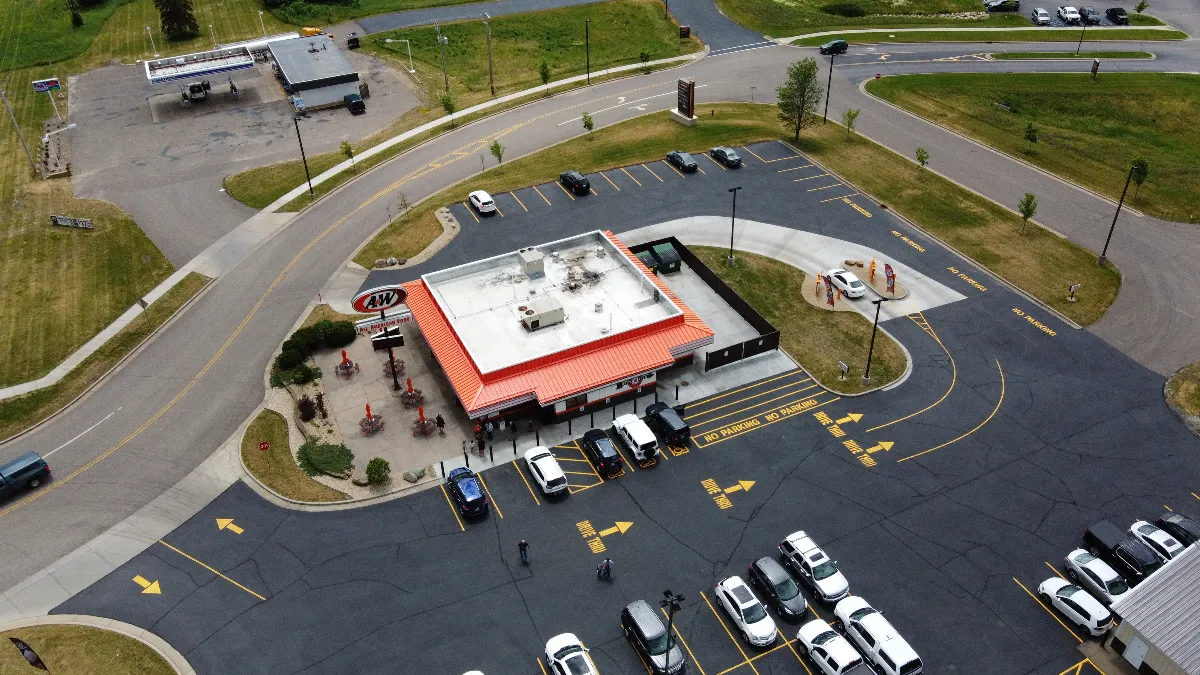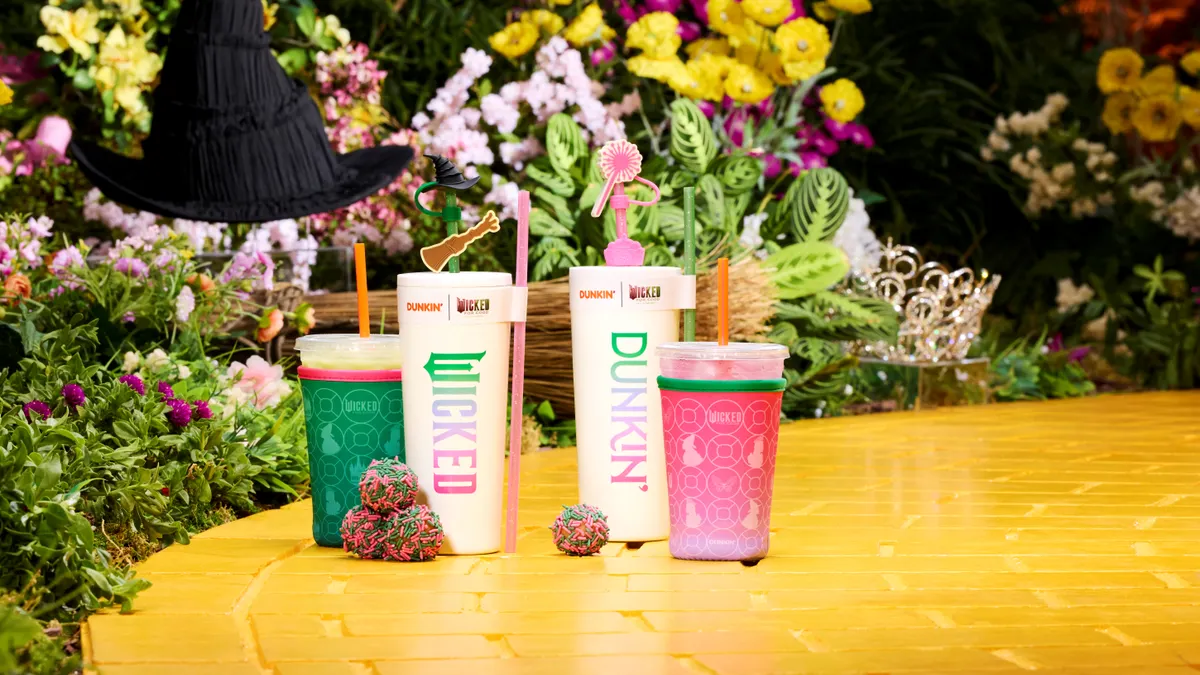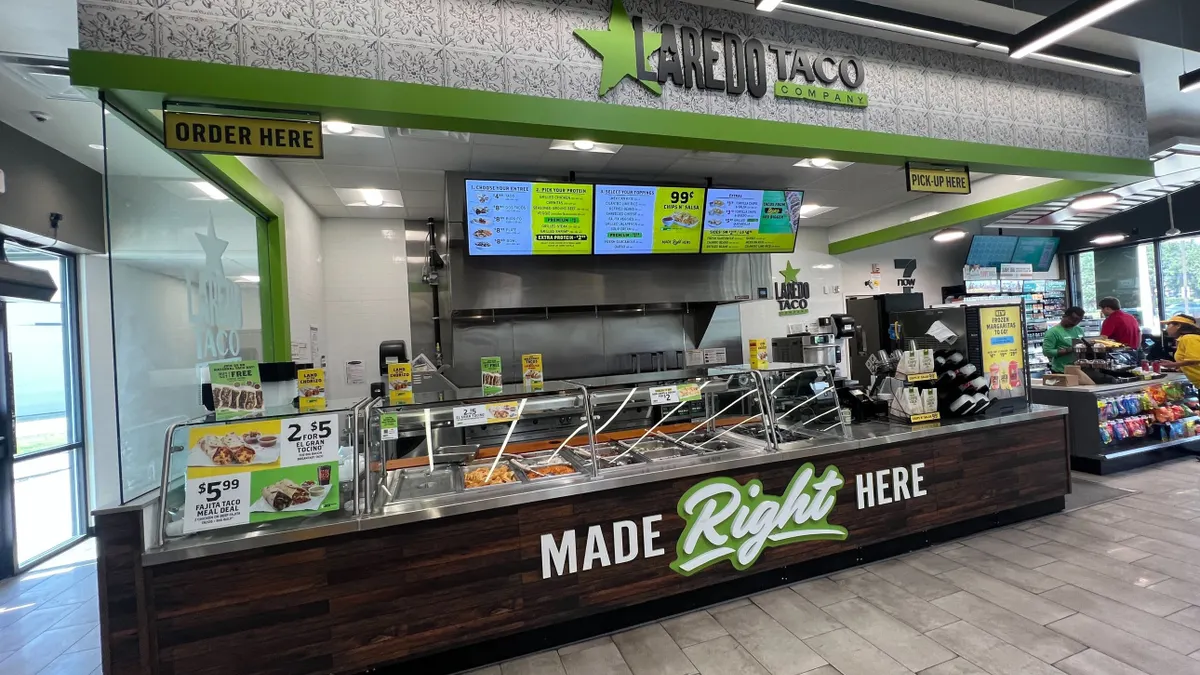This is the fifth and final article in a series exploring strategies chains are deploying to overcome challenges as they expand their drive-thru channels.
Third-generation A&W franchisee Anthony Walker has seen just about every iteration of fast food restaurants. His grandparents set up an A&W in Wisconsin as a roadside stand. That location has since transformed from a drive-in to a drive-thru with a dining room.
A&W has always had a high percentage of business in the dining room, driven by nostalgia and the novelty of getting a root beer in a frosty A&W mug, Walker said. But the COVID-19 pandemic ushered in a new generation of fast food — one that emphasizes the off-premise and drive-thru experience.
Walker, who owns an A&W location in Baldwin, Wisconsin, added a second drive-thru lane in 2020 to take advantage of diner demand for on-the-go meals. But adding a drive-thru took planning and research to ensure a strong ROI. The project cost roughly $80,000. Within the first year it had already paid for itself.
“Drive-thru sales have been through the roof,” Walker said. “We don’t ever see them coming down. … Drive-thru is going to be a big, big piece of our business going forward, probably forever.”
Drive-thru sales are currently up about 40% compared to 2019 at his location, Walker said. Drive-thru sales have started to flatten a bit since dining rooms have opened up, but drive-thru is still Walker’s biggest channel at 60% to 65% of total sales. Annual store sales are expected to reach $2.7 million this year compared to $2.5 million in 2021.
Developing a plan
Walker analyzed successful double drive-thrus, such as Chick-fil-A locations, to inform his own strategy. He noticed that two order points were extended as far back as the property allowed, providing ample time for staff to take and process orders as cars moved through the line.
The operators Walker observed also used a high-tech timer system to gather data on every drive-thru process, from ordering to payment and pickup. This data allowed staff to figure out where bottlenecks were occurring and how to improve speed of service.
When Waker began drive-thru renovations at his location, the second drive-thru lane was built away from the old lane to minimize closure time and disruption to business operations. His restaurant didn’t lose any cash flow during the whole process, he said.
“Drive-thru sales have been through the roof. We don’t ever see them coming down. … Drive-thru is going to be a big, big piece of our business going forward, probably forever.”

Anthony Walker
A&W franchisee, board member of the National A&W Franchisees Association
Walker used analog A&W menu boards and speaker posts since the system doesn’t have digital boards yet, which helped keep construction costs down. Walker did add cabling to the menu boards in case the system shifts to digital boards in the future. Chick-fil-A, which is largely considered a drive-thru leader, doesn’t use a digital menu board either, he said.
“There’s some reasoning behind that,” Walker said. “If you’ve got people outside with an iPad taking the order, [a digital]screen doesn’t really add a lot of value and it doesn’t have any ROI unless you integrate it to your point-of-sales system.”

Ironing out the kinks
Even with careful research and strategy, making the double drive-thru run smoothly was a bit of a learning curve, Walker said. Initially, Walker was concerned that customers wouldn’t merge properly from two lanes to one to pick up their food. Staff started to take customer’s names to confirm orders when drivers pulled up to the window, and to boost a sense of hospitality. Staff also used a timer and camera system to monitor cars and identify customers, he said.
Another issue Walker’s restaurant came across during slow periods is that customers would queue up in lane one without realizing there was a second, less crowded lane available. When it’s busy, both lanes are used constantly, he said. To help clarify that there are two lanes, Walker added big stripes around the building that say “Drive-thru lane one” and “Drive-thru lane two” and added big flags that read “order here.”
While the A&W restaurant initially sent employees to the drive-thru line with tablets to take orders, it moved away from that strategy and instead added another employee inside manning the drive-thru with a headset. The location now has two or three people handling drive-thru orders.
“When your lanes get full, you’ve got a minute of downtime between order taking. Our kitchen can only handle the 10 cars that we have in our stack. … It doesn’t do us much good to give them 12 to 14 cars,” Walker said. “Moving that person inside freed up labor during that minute to make drinks for the next order or help make food for the other order.”
Tips to expand drive-thrus
Walker also serves as a board member for the National A&W Franchisees Association, representing half the A&W stores in Wisconsin, which has the most A&W locations in the country.
The NAWFA has been providing tips to other A&W operators who are considering adding drive-thrus for the first time or adding a second lane. As one of the highest volume A&W restaurants in the country, Walker’s location serves as a guide for other stores in the system, he said. An A&W operator that is building a new location 45 miles away from Walker’s previously visited his store to get a sense of how the double drive-thru lanes work.
While the prospect of boosting drive-thru orders with a second lane is enticing, Walker said not everyone will be able to do it. Operators need to make sure they have enough space on their property for another lane, as well as space in the kitchen to add more equipment if needed to help cook orders. More labor may also be required to complete the higher volume of orders.
“You don’t want to double the cars and then sacrifice the quality, which is our biggest thing at A&W. We basically cook everything to order,” Walker said. “You’ve got to make sure you’ve got the proper amount of real estate inside and outside to make it equitable.”
Drive-thrus can also create traffic and congestion issues, but a second lane can sometimes ease congestion. Prior to the addition of a second lane, cars would be backed up onto the busy highway on A&W’s popular Friday night fish fry, for example, he said.

The future of drive-thrus
In addition to drive-thru growth, A&W is in the process of rolling out an integrated, cloud-based point-of-sale system that could provide better feedback on customer ordering behavior that could inform a future digital menu board, Walker said. Operators could run A-B tests by changing the menu board for different customers to see how ticket sales compare. The POS system has already rolled out at about six stores with more in the works, he said, adding that digital menu boards won’t be required by corporate.
Walker’s biggest challenge with the POS system will be to integrate it with his restaurant’s table service, which is unique to his location since staff take orders tableside and receive tips.
The POS system would also integrate with online ordering for pickup. Walker is also considering adding store kiosks, tablets that function like kiosks for outside order taking and digital menu boards.
Once Walker’s store has implemented the centralized POS system next year, it will be easier to configure a future digital menu board when A&W finalizes its digital board selection.
Walker has already installed a five by 10-inch digital reader board at the drive-thru that shows different advertisements for things like lunch combos, snacks, drinks and ice cream depending on the time of day. This board could also be synced with a digital menu board to advertise specific items.
“The technology is ever changing and there’s so much out there,” Walker said.
While the drive-thru doesn’t have a lot of technology in it now, Walker said he expects the channel to see more innovation, including artificial intelligence applications.
“I'm definitely interested in adding as much technology as we can into our business model, because, you know, it's really going to save us on labor,” he said.




















